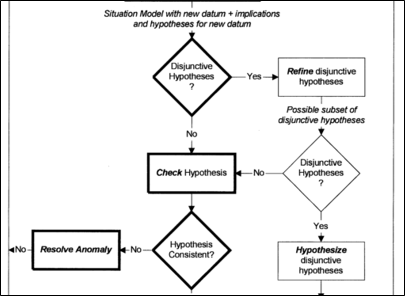TAR Modell
 TAR (Johnson & Krems, 2001),
describes abductive reasoning as a deliberate comprehension process in which observations are sequentially interpreted and integrated into a mental model.
TAR (Johnson & Krems, 2001),
describes abductive reasoning as a deliberate comprehension process in which observations are sequentially interpreted and integrated into a mental model.
Our line of our research combines the testing of process assumptions derived from the TAR model with theories of memory retrieval and memory activation (z.B. Baumann, Mehlhorn, & Bocklisch, 2007; Kintsch, 1998), expertise and routines (z.B. Krems & Zierer 1994;), strategy usages such as exemplar-based reasoning strategies (z.B. Scholz, von Helversen, & Rieskamp, 2015). We use the Black Box task to assess these processes. In this experimental paradigm symptoms are presented in a sequential order and the task has a complexity comparable with that of everyday life problems. Still, the task is learnable in an experimental setting and controls for prior knowledge of the participants. To solve this task, participants are asked to locate atoms in the Black box based on light rays which are shot in the Black Box. The rays are broken and absorbed to specific rules which allow judgements referring to the location of the atoms. The combination of the Black Box task with eye tracking gives us the tools to make detailed assumptions to the processes concerning diagnostic reasoning.
References
-
Baumann, M. (2000). Die Funktion des Arbeitsgedächtnisses beim abduktiven Schließen: Experimente zur Verfügbarkeit der mentalen Repräsentation erklärter und nicht erklärter Beobachtungen.
-
Baumann, M. R. K., Mehlhorn, K., & Bocklisch, F. (2007). The activation of hypotheses during abductive reasoning. Proceedings of the 29th Annual Cognitive Science Society, 803-808. Retrieved from http://csjarchive.cogsci.rpi.edu/proceedings/2007/docs/p803.pdf
-
Evans, J. S. B. T. (2006). The heuristic-analytic theory of reasoning: extension and evaluation. Psychonomic Bulletin & Review, 13(3), 378-395. doi:10.3758/BF03193858
-
Johnson, T. R., & Krems, J. F. (2001). Use of current explanations of multicausal abductive reasoning. Cognitive Science, 25, 903-939. doi:10.1016/S0364-0213(01)00059-3
-
Keinath, A. (2002). Anomalieresolution bei abduktivem Schließen: Experimente zur Hypothesenbildung und Strategieauswahl beim Problemlösen. Philosophische Fakultät. Retrieved from http://archiv.tu-chemnitz.de/pub/2003/0125\nhttp://archiv.tu-chemnitz.de/pub/2003/0125/index.html
-
Keinath, A.& Krems, J. (1998). The Influence of Anomalous Data on Solving Human Abductive Tasks. Philosophica, 61, 39-50.
-
Kintsch, W. (1998). Comprehension: A paradigm for cognition. New York, NY: Cambridge University Press.
-
Krems, J. F., & Zierer, C. (1994). Sind Experten gegen kognitive Täuschungen gefeit? Zur Abhängigkeit des confimation bias von Fachwissen. Zeitschrift Für Experimentelle Und Angewandte Psychologie, XLI(1), 98-115.
-
Mehlhorn, K., Taatgen, N. a., Lebiere, C., & Krems, J. F. (2011). Memory activation and the availability of explanations in sequential diagnostic reasoning. Journal of Experimental Psychology: Learning, Memory, and Cognition, 37(6), 1391-1411. doi:10.1037/a0023920
-
Scholz, A., von Helversen, B., & Rieskamp, J. (2015). Eye movements reveal memory processes during similarity- and rule-based decision making. Cognition, 136, 228-246. doi:10.1016/j.cognition.2014.11.019
-
Sloman, S. A. (1996). The empirical case for two systems of reasoning. Psychological Bulletin, 119(1), 3-22. doi:10.1037/0033-2909.119.1.3





